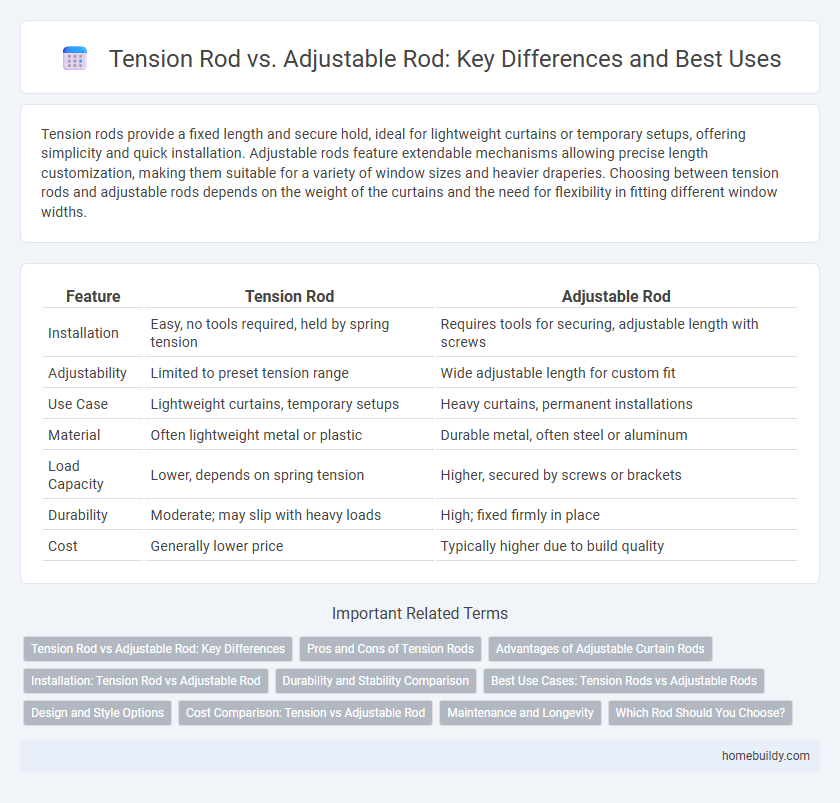Tension rods provide a fixed length and secure hold, ideal for lightweight curtains or temporary setups, offering simplicity and quick installation. Adjustable rods feature extendable mechanisms allowing precise length customization, making them suitable for a variety of window sizes and heavier draperies. Choosing between tension rods and adjustable rods depends on the weight of the curtains and the need for flexibility in fitting different window widths.
Table of Comparison
| Feature | Tension Rod | Adjustable Rod |
|---|---|---|
| Installation | Easy, no tools required, held by spring tension | Requires tools for securing, adjustable length with screws |
| Adjustability | Limited to preset tension range | Wide adjustable length for custom fit |
| Use Case | Lightweight curtains, temporary setups | Heavy curtains, permanent installations |
| Material | Often lightweight metal or plastic | Durable metal, often steel or aluminum |
| Load Capacity | Lower, depends on spring tension | Higher, secured by screws or brackets |
| Durability | Moderate; may slip with heavy loads | High; fixed firmly in place |
| Cost | Generally lower price | Typically higher due to build quality |
Tension Rod vs Adjustable Rod: Key Differences
Tension rods rely on spring mechanisms to create pressure, securing themselves between two surfaces without drilling, ideal for lightweight applications and easy installation. Adjustable rods feature extendable sections with screw or twist locks, allowing precise length customization for heavier loads and more permanent fixture options. Choosing between a tension rod and an adjustable rod depends on load requirements, installation type, and desired stability.
Pros and Cons of Tension Rods
Tension rods provide a simple, tool-free installation method ideal for lightweight curtains and temporary setups, relying on spring tension for support. Their major limitation is reduced stability under heavy loads or in high-traffic areas, often leading to slipping or falling. Adjustable rods offer enhanced versatility in length but may require drilling or mounting hardware, making tension rods preferable for renters or quick adjustments.
Advantages of Adjustable Curtain Rods
Adjustable curtain rods offer versatile sizing options that easily accommodate different window dimensions, providing a perfect fit without the need for custom measurements. These rods feature simple mechanisms for length alteration, allowing quick installation and hassle-free adjustments whenever the curtains or window treatments change. Their adaptability reduces the need for multiple rod purchases, making them a cost-effective and practical solution for varying interior design needs.
Installation: Tension Rod vs Adjustable Rod
Tension rods install easily without drilling, relying on spring tension to fit securely between surfaces, making them ideal for quick, damage-free setups. Adjustable rods often require screws or brackets for mounting, providing a more stable and permanent installation suitable for heavier loads. Choosing between the two depends on the desired balance between installation simplicity and support strength.
Durability and Stability Comparison
Tension rods provide superior stability due to their fixed length and robust spring mechanisms, ensuring consistent pressure and resistance against movement. Adjustable rods offer flexibility in length but may sacrifice durability as repeated adjustments can weaken their structural integrity. For long-term use in high-stress environments, tension rods typically outperform adjustable rods in maintaining steady support and resisting wear.
Best Use Cases: Tension Rods vs Adjustable Rods
Tension rods are ideal for lightweight curtains and quick, tool-free installation in small spaces or rentals where wall damage is a concern. Adjustable rods offer greater versatility and strength, making them suitable for heavy draperies or uneven wall widths requiring precise length customization. Choosing tension rods enhances convenience and portability, while adjustable rods provide structural support for varied curtain types and larger windows.
Design and Style Options
Tension rods offer sleek, minimalist designs ideal for lightweight curtains and small spaces, emphasizing simplicity and ease of installation without drilling. Adjustable rods provide versatile sizing and a broader range of styles, including decorative finials and materials, catering to various interior design preferences. Choosing between tension and adjustable rods depends on balancing aesthetic goals with functional flexibility in curtain hanging.
Cost Comparison: Tension vs Adjustable Rod
Tension rods generally offer a lower initial cost compared to adjustable rods due to their simpler design and fewer moving parts. Adjustable rods, while typically more expensive upfront, provide versatile length options that can reduce the need for custom measurements or additional fittings, potentially lowering overall installation costs. When selecting between tension and adjustable rods, consider both the purchase price and the potential savings from ease of installation and adaptability.
Maintenance and Longevity
Tension rods require minimal maintenance due to their simple spring-loaded mechanism, which reduces wear and tear over time, leading to enhanced longevity. Adjustable rods, featuring multiple moving parts and locking components, may need regular tightening and inspection to prevent loosening or damage, potentially shortening their lifespan. Choosing tension rods often results in longer-lasting performance with less frequent maintenance compared to adjustable rods.
Which Rod Should You Choose?
Tension rods provide quick, tool-free installation and rely on spring tension to hold securely, making them ideal for lightweight curtains and temporary setups. Adjustable rods offer customizable length adjustments with screws or twist mechanisms, supporting heavier curtains and more permanent installations. Choose tension rods for easy, damage-free mounting and adjustable rods for maximum strength and precision fit.
Tension rod vs Adjustable rod Infographic

 homebuildy.com
homebuildy.com